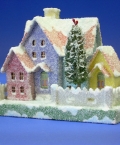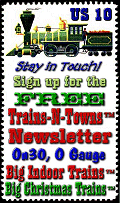
|
||||
| Your source for custom-made, handcrafted Christmas village houses and churches | ||||

| HOME PAGE |
PHOTO GALLERY |
ORDERING DETAILS |
ABOUT THE CRAFTSMAN |
HOUSE KIT |
HOWARD'S HOW-TO'S |
FAVORITE LINKS |
| Written by Howard Lamey (with a little help from Paul Race) for Big Indoor Trains™ and LittleGlitterhouses.com. |


|
Building a GlitterhouseNote from Editor: Howard Lamey, in Jacksonville, Florida, has retired from a full-time job in advertising that included designing window displays for a major retailer. Now he has turned those artistic talents to designing and building Also, you should know that most collectors and builders of vintage pasteboard houses call them "putz" houses because they were often used in "putzes," the German-American term for Christmas villages of the 1930's-1950's. If most of this information is new to you, you can read up on these classic cardboard Christmas communities in the Big Indoor Trains "What is a Glitterhouse?" article. The house shown in the photo is a good starting product for learning to build "putz" houses. What You Will NeedIf you are going to build vintage-style cardboard houses, stop throwing away used, clean cardboard yesterday. Save cereal boxes, the backs of writing tablets, anything flat, firm and clean, that you can save. Please keep some corrogated cardboard on hand, too - it makes the best bases. In addition, for this project you'll need:
Note:: Our article on What You Need to Build Glitterhouses lists many other materials and tools that will help you work more quickly and effectively. Printing the Plans
Double-click on the plans above to see the large versions. You should be able to print the big version at the size you need either of the following ways.
If neither of those work, contact Paul and ask him for help - that's his department. :-) Building the BaseThe base is a rectangular "box" that is decorated before the house and trees are installed. For this project, it should be about 4 1/4" square, and about 1/2" high.
Note: For this project, Howard cut the base and fence pieces out at the same time. The fence pieces are made from card stock such as posterboard or cereal box cardboard. If you wish, you may use different materials for the fence, including miniature wooden snow fence from the craft store or a rustic rail fence you make from twigs. Cut And Glue The Base - Usually the best method is to make a base from layers of corrugated cardboard glued together in a sandwich. You then wrap and glue a strip of thin poster-board or cereal-box cardboard all around it to camouflage the rough edges of the corrugated cardboard.
Wrap the Base - When the base is built, you then cover it with white bond paper just like you would wrap a gift, except that all surfaces of the paper cover must be glued down to the box. A glue stick works great for this.
Note: More details about building bases are provided in our article: Building Glitterhouse Bases Attach the Fence - When the glue on the base has dried, glue the fence pieces to the base. Prime the Base - When all the glue has dried, paint the base with the flat white paint. This provides an even finish that will hold the acrylic paint and glitter. If the fence is made of card stock, prime it, too. Prepping the Structure PiecesThe house, roof, chimney, and chimney cap need to be cut from thicker cardboard, such as the cardboard from the back of a writing tablet.
Assembling and Painting the House
|
 |
 Bonus: Church Conversion Plans
Bonus: Church Conversion Plans
When you're done with your first house, and thinking about the next project, here's an idea. Many glitterhouse sets had seven houses (often identical except for colors and accessories) and a church. If you want your glitterhouse collection to represent that tradition, you can use the plans below in addition to the plans and directions above to convert your next putz house into a church.
 |
As always you have two options for downloading and printing the plan:
If you do build a church, you'll find a stained glass window pattern you can use on Paul Race's Free Large Scale Signs and Graphics web page.Also, if you find yourself looking for the old-fashioned celophane with gold windowframes printed on it, you'll find many choices at Papa Ted's Reproduction Parts page.
The following photos show the steps in building a church the same basic way you build the little glitterhouse above. Note that in this version of the project, Howard changed the shape of the windows and added two, but the basic process is the same.
Commercial "Plug"
A Note from the Designer: Now that I'm in "retirement," this hobby has become a sort of avocation for me. Several folks have commissioned me to build specific houses for them. So if you'd like me to "bid" on a cardboard house for you, or if you have any questions at all, please visit our Orders page. - Howard
Also, if you have a similar project you'd like to share with your fellow readers and hobbyists, we'd love to add it to our site, and we'll be sure to give you full credit for your contribution.
Other Resources for Putz Houses and Related Information
- Other Putz House Articles:
- Building Glitterhouse Bases
- What You Need to Build Glitterhouses
- What is a Glitterhouse? - The BigIndoorTrains™ introduction to the hobbies of collecting and building glitterhouses.
- Building the Little Charmer - A new glitterhouse project that is a step up from our beginning glitterhouse, includes free downloadable plans and instructions.
- Welcome to Spook Hill™ - Howard has designed a whole, family-friendly, Halloween community built in the vintage "putz-house" style. Featured structures so far include:
- Spook Hill™ #1 - Shakey Pane Manor - Here's a new Halloween-themed building project that based on forms typically used in some of the more elaborate cardboard Christmas houses that were made in Japan between 1920 and 1930. Includes free downloadable plans and instructions.
- Spook Hill™ #2 - Spook Hill Station - Here's the first-ever Halloween-themed train station craft project. This is the second of our series of Spook Hill™ buildings, designed to look good with Halloween Trains of all kinds, and to get your community ready to receive guests by Halloween, includes free downloadable plans and instructions.
- Other Putz House Resources:
- LittleGlitterHouses.com - In case you aren't already on Howard's site, this will take you there. Putz house builder Howard Lamey now has his own site, begun in December, 2007. You can commission your own custom-built glitterhouse, or buy a precut kit and finish it yourself.
- "Papa Ted's Place" Ted Althof's extensive resource about vintage pasteboard houses. Includes some history, many photos from other people's collections, and resources to help you build your own. The links below will take you right to the approprate page on "Papa" Ted's site. You'll find lots of other pages to look at while you're there, though.
- Building from Scratch - "Papa" Ted Althof has collected tips and photos from other glitterhouse builders including Tom Hull and Ted Howard.
- Repair and Restoration - "Papa" Ted Althof publishes Tom Hull's tips for restoring damaged antique glitterhouses.
- Reproduction Parts - Ted offers authentic reproductions of just about every door and window that were used in glitterhouses over a 35-year period. These include celophane and paper "see-through" windows, as well as "stick-on" windows. If you don't know what sizes you need, you can order a template or sample pack. The page includes several photos showing how the replacement parts bring otherwise solid vintage glitterhouses "back to life."
- Making "Flocked" Windows - Tom Hull's method for making "fuzzy" windowframes on celophane, with additional tips by author and glitterhouse collector Antoinette Stockenberg.
- Repairing or Replacing Trees Tom's article about the "lufa" trees that were common on pre-war glitterhouses, and can be repaired or else replaced by new lufa carefully cut, soaked with dark green acrylic paint, and allowed to dry before gluing and applying white paint for "snow."
- Other Articles that Discuss Putzes and Christmas Villages of the mid-20th Century:
- About Nativities - Describes how German-American Nativity displays (the original "putzes") grew into communities and landscapes that included pastboard, glittered houses and even electric trains.
- What Do Trains Have to Do With Christmas - Describes how electric trains contributed to the communities many families set up at Christmas, with some details about the elaborate "Christmas Gardens" of the Baltimore/DC area.
- Author Antoinette Stockenberg's home page - includes photographs and comments on putz houses and life in general.
To return to the "Howard's How-To" page, click here.
































